
John Stumpf, CEO Wells Fargo, Kenneth D. Lewis, Chairman, CEO, and President of Bank of America, U.S. Bancorp CEO Richard Davis, John Mack CEO of Morgan Stanley, Vikram Pandit, CEO of Citigroup, John Koskinen, CEO of Freddie Mac, and others walk out of the White House after a meeting with U.S. President Barack Obama at the White House on March 27, 2009.
It's deadline day for banks. The nation's 19 largest lenders have spent the past month trying to prove to regulators they are financially strong. Today, we will start to find out if their efforts have been enough.
When the stress tests were completed last month, the Treasury Department and regulators gave banks deemed to need capital a month to detail how they would raise it. For the banks that passed the stress test, they were told to report back on how they plan to repay taxpayers. Monday, June 8, was set as the deadline for turning in those plans to regulators. (See 25 people to blame for the financial crisis.)
For many of the banks deadline day will pass with little fanfare. Like the stress test before, the month of preparation the banks have had before submitting their capital plans has in general shown that the banking industry is stronger than many thought. Banks were able to raise capital in May and early June with surprising ease. Selling new shares usually makes a company's stock price go down because the earnings-per-share pie gets cut up into more slices. But many of the banks have been able to raise cash and have their stock price continue to rise. J.P. Morgan, for instance, raised $5 billion in May, yet its stock price rose 14% over the course of the month. All told, the 19 stress-tested banks have raised a total $65 billion since the test was completed.
The result is that many more banks than expected have the resources to repay the billions they got from the Troubled Asset Relief Program back in October. Morgan Stanley, for instance, came out of the stress test a month ago in need of $1.8 billion in additional capital. But in the past month the bank was able to raise nearly $7 billion by selling new shares of stock. The result: Morgan says those stock sales and other moves will allow the bank to repay all of its TARP funds by the end of June. And Morgan won't be alone. All told, eight of the 19 banks will tell regulators that they plan to pay back their TARP funds in the near future. (Watch TIME's video of Peter Schiff trash-talking the markets.)
But like any class on presentation day, there will be some sweaty palms. Bank of America and Wells Fargo say they have raised enough money to satisfy regulators, but they only detail a portion of their efforts. The Federal Deposit Insurance Corp., which also gets to weigh in on whether banks' plans are adequate, has been pushing for management changes at some of the banks. Last week, Bank of America was forced to replace its chief risk officer and four of its board members. Reportedly, the FDIC would like Citigroup to dump its chief executive Vikram Pandit. So far, members of the Citi board of directors have said they have no plans to replace Pandit. (Read "Has Wells Fargo Stock Run Too Far?")
Then there is Fifth Third Bancorp. The Cincinnati-based financial firm is one of a number of banks that have had to spend the past month pulling off some fancy financial gymnastics to meet their capital requirements. The stress test found that Fifth Third was $1.1 billion short of the common equity it needed to be considered well funded. Earlier this week, the bank announced that it had raised $1 billion by selling new stock. But that left the bank $100 million short of its goal. So the bank couldn't stop there. Instead, it offered $365 million of the money it just raised to preferred shareholders in order to get them to convert their stock into common shares. Common shares counted as capital in the stress tests. Preferreds did not.
The move seems to have worked. Fifth Third says the cash payments were enough to persuade holders of more than $550 million in preferred stock to convert their shares to common. Add that amount to the more than $600 million Fifth Third had left from its stock offering, and bingo: Stress test passed — over $1.1 billion in new common equity. The problem is the money Fifth Third paid to preferred shareholders to convert to common equity will also end up depleting Tier 1 capital — a measure of total bank resources, not just common equity — by $365 million.
In a recent note to clients, analyst David Hendler of research firm CreditSights wrote, "Net-net, we believe that the announced actions are considerably dilutive to the company's shareholders, yet they could put to rest the dire perception that many investors had about Fifth Third, at least for now."
The same could be said of all the banks.
